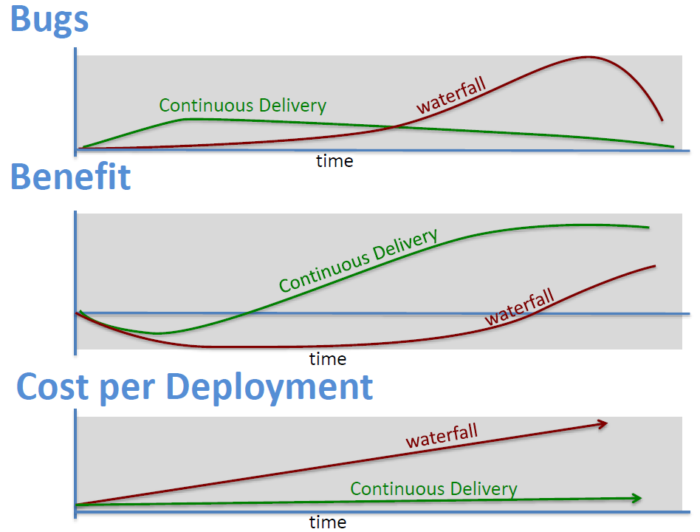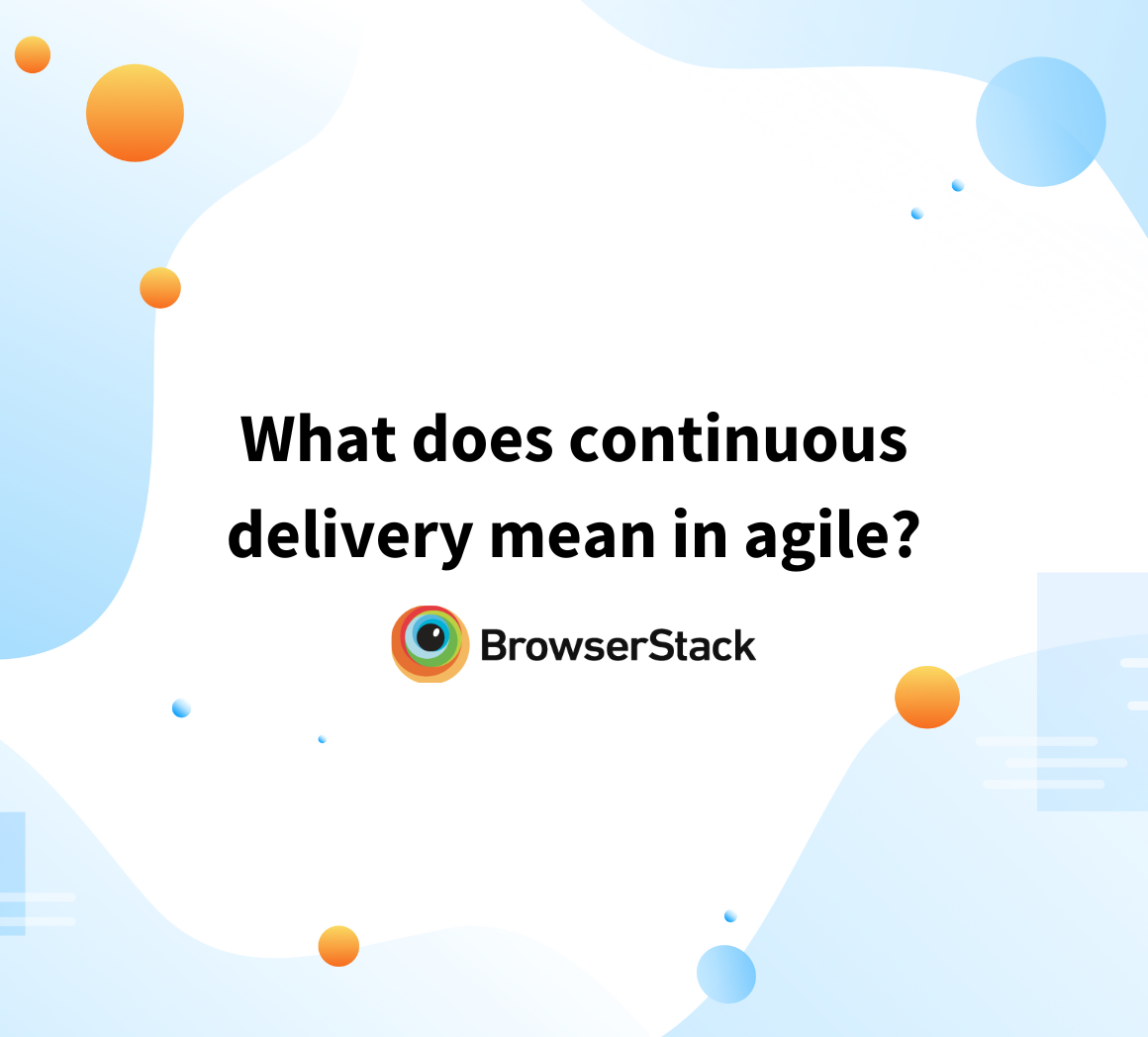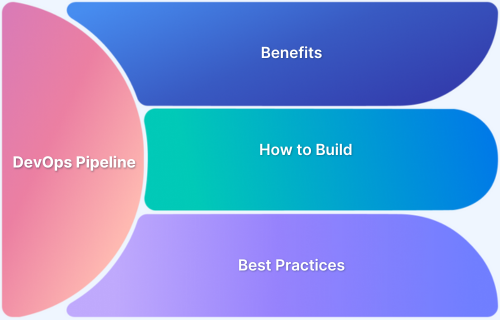Continuous Delivery (CD) is an important part of DevOps that helps teams deliver software updates quickly and safely.
Overview
What is Continuous Delivery (CD)
Continuous Delivery (CD) automates the steps of building, testing, and deploying software. It ensures that code changes are always ready for deployment with minimal manual intervention.
Role of CD in the CI Pipeline
CD builds on continuous integration (CI) by automating the deployment of code changes to testing or production environments after the build and testing stages.
Some Benefits of Continuous Delivery:
- Faster Releases: Helps teams get features and updates to customers more quickly.
- Lower Risk: Reduces the chances of problems during releases by making smaller changes more often.
- Better Teamwork: Improves communication and collaboration between developers and operations teams.
- Higher Quality: Leads to better software by catching bugs early through regular testing.
- More Flexibility: Allows teams to quickly respond to customer feedback and changes in the market.
Key Features of Continuous Delivery:
- Automated testing for ensuring code quality and stability with each release.
- Continuous monitoring of system performance post-deployment for quick issue detection.
- Seamless integration with Continuous Integration (CI) to deploy the latest code changes continuously.
- Support for multiple deployment pipelines to test and deploy across different environments.
- Rollback capabilities that allow easy reversion to a stable version if issues occur.
- Integration with version control systems to track changes and manage releases effectively.
- Centralized environment configuration management for consistency across development, staging, and production environments.
- Scalable infrastructure to handle higher loads as updates are deployed continuously.
Popular CD Tools:
- Jenkins: Open-source automation server for CI/CD.
- GitLab CI/CD: Integrated CI/CD solution within GitLab.
- CircleCI: Cloud-based platform for robust CI/CD pipelines.
- Azure DevOps: Comprehensive CI/CD and DevOps tool by Microsoft.
To make CD effective, implement strong automated testing and maintain streamlined deployment pipelines to minimize manual work and reduce risks.
This article will explain Continuous Delivery, how progressive exposure techniques improve it, and why BrowserStack is a great tool for supporting this process.
What is Continuous Delivery in DevOps
Continuous Delivery is a process that automates the steps needed to build, test, and deploy software. It ensures that code changes are always ready to go live with minimal manual work.
Continuous delivery (CD) is a software development methodology in which code modifications are automatically packaged and deployed to production. It aims to accelerate development, cut expenses, and lower risks without losing code quality.
CD is attained by designing a simple release procedure that is easily reproducible and restricts manual activities. In an ideal CD procedure, only application deployment into production requires human participation.
Once a development team has accomplished continuous integration, CD is the next step in software pipeline automation (CI). CI automates the merging and testing of code modifications, focusing particularly on unit testing. The application is deployed to a staging environment for additional testing once the code has passed evaluations. These assessments consist of integration testing, performance testing, user interface testing, and more.
CI and CD constitute the CI/CD pipeline, which transfers code from the computers of individual developers via automated testing to a production-ready build. At this point, all that is required is for a team member to deploy the latest version manually, often at regular intervals. With the emphasis on automation and velocity, CI/CD is a pillar of the DevOps concept.
Evolution of Continuous Delivery in DevOps
In a typical waterfall lifecycle, a customer release (minor or major) is a significant milestone that requires months of work. The entire crew is focused on achieving this objective. The release’s features are developed, tested, and merged into the main branch as a single unit. There is a huge cost associated with failed releases and intense pressure to achieve deadlines. Consumers also wait lengthy durations for resolutions to their problems. Significant downtime occurs when the release patch is applied.
Contrast this with the Agile model’s shorter release lifecycle. Here, features can be checked into the central repository every day (Continuous Integration). Automated suites of unit, regression, and system tests ensure that freshly contributed code is quickly validated. Effect on relevant characteristics is examined. If this code can then be deployed promptly to customers, the strain surrounding a customer release is eliminated. Releasing becomes a common, low-risk, and automated occurrence. Manual errors are eliminated from the releasing procedure. Even during holidays, urgent fixes and updates can be issued with minimum manpower. This led to the evolution of Continuous Delivery.
Benefits of Continuous Delivery in DevOps
Below are some key benefits of Continuous Delivery in DevOps:
Key Benefits of Continuous Delivery in DevOps:
- Quicker Detection of Defects
- Reduction of Costs
- Improved Quality
- Reduced Risk
- Increased Employee Satisfaction
- Hastened Product Delivery
Here is an explanation of the key benefits:
- Quicker Detection of Defects: Continuous Delivery employs robust testing techniques to automatically validate an application’s behavior after deployment. This helps uncover flaws before reaching production, preventing disruptions for users. Developers can address these flaws early, boosting user satisfaction and improving future releases.
- Reduction of Costs: By eliminating manual processes and streamlining delivery pipelines, CD reduces the cost of deploying new features or upgrades. Teams can focus on strategic tasks, increasing productivity without the need for additional resources.
- Improved Quality: CD ensures applications meet user needs by standardizing requirements into test cases. It also facilitates quicker delivery of MVPs for immediate customer feedback, enabling teams to adjust and enhance products promptly.
- Reduced Risk: CD minimizes deployment risks by standardizing release processes and validating changes through rigorous testing. This builds confidence in the application’s stability and ensures smoother rollouts.
- Increased Employee Satisfaction: Automating repetitive tasks allows developers to focus on creative and high-impact work. Faster deployment pipelines also provide immediate feedback on their contributions, making the development process more rewarding.
- Hastened Product Delivery: CD eliminates bottlenecks, allowing features and updates to be deployed as soon as they are validated. This speed advantage is especially valuable for addressing critical issues like security patches, ensuring timely solutions.
Also Read: How to implement a CI/CD Pipeline?
How Does Continuous Delivery Work?
Continuous delivery pipelines extend the operations and technologies currently implemented for a CI pipeline. Throughout the CI process, the code has been compiled to construct the application and unit-tested to ensure its functionality and quality. If the application fails to build or the unit tests fail, the code is returned to the developers to remediate and test again.
Now, the application is prepared for additional testing. You will need a method to generate a staging environment identical to the production setting. Development teams generally resort to cloud services to provide a multistage environment to host the application and organise the testing workflow, since cloud hosting can expand to match processing demands.
A CD pipeline may contain quality gates that establish success criteria. Before the program may advance to the subsequent phase, the performance, integration, and user interface (UI) tests must achieve these criteria. AI may be effective for identifying failure causes and viable solutions.
You should automate as many tests and processes as possible as part of this testing strategy. This reduces the risk of human mistakes associated with manual methods, such as executing tests in a different order, as well as enhances speed. Everything related to Continuous Delivery in DevOps should be uniform and repeatable.
Lastly, invest in observation and monitoring systems, as a failure in one segment of the pipeline could cause the entire system to fail. Including automated alarms and redundancies will ensure that, for instance, the failure of a single testing tool does not affect client delivery.
A Case Study of Continuous Delivery in DevOps
Without executing Acceptance Tests in a production-like environment, developers have no idea if the application fulfils the customer’s requirements or can be deployed and survive in the real world. They must expand the scope of their continuous integration process if they want quick input on these topics.
The developers thus took Continuous Integration (Continuous Delivery) to the next level by introducing a few simple, automated Acceptance Tests that demonstrated that the application operated and could perform its most basic job.
Essentially, they designed a Continuous Delivery pipeline to ensure that the application is deployed effortlessly on the production environment by ensuring that the program functions properly when installed on a replica of the production server.
Progressive exposure techniques in continuous delivery
Progressive exposure is a way to release updates gradually instead of all at once. This helps catch problems early and protects users from issues.
Some common progressive exposure methods include:
1. Limiting Blast Radius:
- CD supports progressive exposure patterns to limit the risk of deployments by gradually increasing exposure to users.
- These techniques help minimize the impact of potential issues on the overall user base.
2. Deployment Rings:
- CD can sequence deployments through multiple rings or user groups.
- The process starts with a smaller group, like a canary deployment, to test new versions in production.
- User experience is monitored in each ring before moving to the next stage.
- CD automates the progression between rings, ensuring a controlled rollout.
3. Manual Approvals:
- Deployment to the next ring can include a manual approval step where changes are reviewed and signed off electronically.
- CD keeps an auditable record of these approvals to meet regulatory or compliance requirements.
4. Blue/Green Deployments:
- This technique deploys a new “green” version while keeping the current “blue” version live.
- Traffic is gradually shifted to the green version using load balancing.
- If issues arise, traffic can be redirected back to the blue version to ensure continuity.
5. Feature Flags:
- Feature toggles allow controlled activation of new features for specific user groups.
- This enables experimentation and “dark launches” without exposing unfinished features to all users.
6. Fast and Safe Deployments:
- Modern release pipelines enable development teams to deploy updates quickly and safely.
- CD supports rapid issue resolution by rolling forward with a new deployment if a problem is detected.
- This ensures a continuous flow of value to customers while maintaining reliability.
Why use BrowserStack for Continuous Delivery in DevOps?
BrowserStack is a cloud-based testing platform that helps teams test their apps across different devices and browsers. It’s a great tool for Continuous Delivery because it ensures that updates work well for all users, no matter what device or browser they use.
Some of the notable features include:
- Real Devices: Test apps on 3500+ real devices and browsers without needing your own lab.
- Easy Integration: Works with popular CI/CD tools like Jenkins, GitHub Actions, and Azure DevOps to automate testing in your pipeline.
- Faster Testing: Run multiple tests at the same time to save time and speed up delivery.
- Thorough Testing: Test everything from functionality to performance and visual appearance.
- Supports Gradual Rollouts: Helps test canary releases and feature toggles in real-world conditions.
- Simulated Real-World Scenarios: Provides a realistic environment for testing, ensuring apps work flawlessly across different devices and configurations.
Conclusion
After a team has mastered the CI pipeline, the next stage in automating the development process is continuous delivery (CD). Based on the demands of the client and the organisation, DevOps teams may progress beyond continuous delivery to continuous deployment and streamline the entire pipeline from code to customer. In this circumstance, continuous delivery is still an intermediate step toward the ultimate objective of automated deployments.
Continuous Delivery in DevOps is used to automate and standardise the testing process for applications to ensure their readiness to satisfy real-world user needs. In addition to numerous additional benefits for developers and their clients, this technique identifies errors faster, improves product quality, and reduces development costs.
However, all tests, including unit tests, need to be conducted on real devices for optimum results. Testing is only 100% effective when the tests are executed under real user conditions. Emulators/Simulators and Virtual Machines cannot fully replicate the specific conditions under which devices operate and thus, their results do not inspire sufficient confidence to push the code to production.
For both manual testing and automated Selenium testing, real device testing is absolutely crucial in obtaining reliable results. Organisations prefer cloud-based testing infrastructure in order to avoid the prohibitive costs of setting up an in-house lab.










